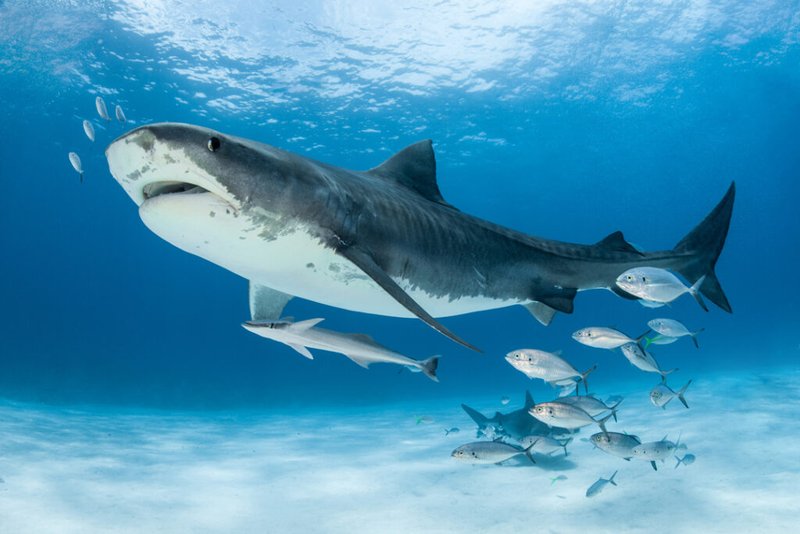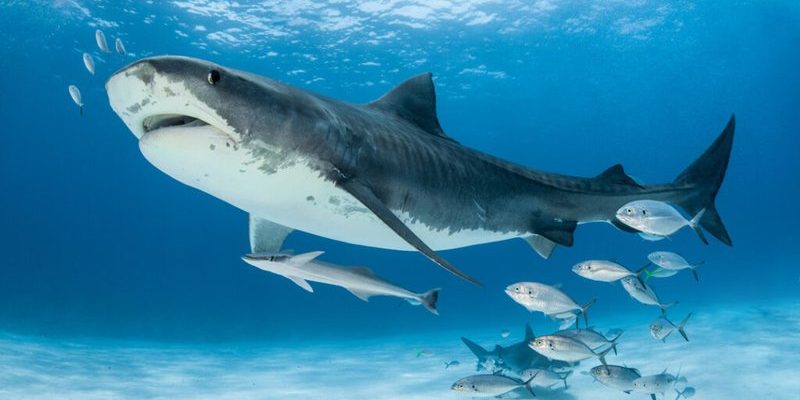
Tiger sharks are often labeled as “garbage eaters” because they consume almost anything. While this might sound a bit gross, it’s actually a crucial job. By munching on sick, weak, or dead animals, they help keep the ocean clean and functioning well. So, let’s dive deeper into the world of tiger sharks and explore their important role in marine ecosystems.
A Brief Overview of Tiger Sharks
Tiger sharks, scientifically known as *Galeocerdo cuvier*, are one of the most unique species in the ocean. They can grow up to 14 feet long and weigh over 1,400 pounds! These sharks are easily recognizable by their distinctive dark stripes and a more blunt snout compared to other shark species. They inhabit tropical and subtropical waters, often hanging out near coral reefs and the open ocean.
What sets tiger sharks apart from other sharks is their varied diet. These sharks are opportunistic feeders, which means they’ll eat whatever is available. That’s why they’re often referred to as “the garbage cans of the sea.” Their diet includes fish, seals, birds, and even sea turtles. This diverse eating pattern helps regulate the populations of these animals, which is a key part of their ecological role.
The Tiger Shark as a Top Predator
As a top predator, tiger sharks help maintain balance in marine ecosystems. You might be wondering how that works. Well, by preying on weaker or sick animals, they help keep those populations healthy. Think of it like a natural filter that prevents overcrowding and disease.
This predation doesn’t just benefit the prey species, however. It also supports the entire marine environment. For example, when tiger sharks keep prey fish populations in check, it allows other marine life to thrive. Healthy fish populations contribute to coral reef health, which in turn supports countless other species. It’s all interconnected!
Why Are Tiger Sharks Important for Coral Reefs?
Coral reefs are often called the “rainforests of the sea” because they’re home to a staggering variety of species. Tiger sharks play a significant role in keeping these ecosystems robust. When they hunt, they help control the populations of herbivores like parrotfish, which feed on algae. If herbivore numbers are left unchecked, algae can proliferate and smother corals, harming the entire reef system.
By keeping herbivore populations balanced, tiger sharks ensure that coral reefs remain healthy and vibrant. This, in turn, provides habitats for many other marine species and supports local communities that rely on these ecosystems for food and tourism.
Understanding the Tiger Shark’s Feeding Habits
Tiger sharks have a fascinating and adaptable way of finding food. They have strong jaws and sharp teeth, which allow them to consume a wide range of prey. Their sense of smell is incredibly keen, enabling them to detect blood from miles away, helping them locate injured animals. Here’s the thing: they often eat things that might not seem like food at all, including plastic debris!
This adaptability is crucial for their survival, especially in changing environments. However, it can also be problematic when they inadvertently consume human-made waste. This not only affects their health but can disrupt the entire ecosystem as pesky plastic makes its way through the food chain.
The Conservation Status of Tiger Sharks
Despite their importance, tiger sharks face threats due to overfishing, habitat loss, and pollution. Many populations are declining, which raises concerns about the impact on marine ecosystems. The loss of tiger sharks could lead to an increase in prey species, which might sound good, but it can actually lead to negative consequences for coral reefs and other marine life.
Conservation efforts are essential to protect these magnificent creatures and the balance they create in the ocean. By supporting sustainable fishing practices and reducing plastic waste, we can contribute to the health of tiger shark populations and, ultimately, the marine ecosystems they help maintain.
The Future of Tiger Sharks and Marine Ecosystems
Looking ahead, the future of tiger sharks and marine ecosystems depends on our actions today. The ocean is a delicate balance of life, and every species plays a part—even the tiger shark. As we become more aware of our impact on the environment, we can take steps to ensure these predators thrive in their habitats.
You might be wondering what you can do to help. Simple actions like reducing plastic use, supporting marine conservation organizations, and spreading the word about the importance of tiger sharks can make a big difference. The more we learn and share, the better equipped we are to protect our oceans.
In conclusion, the tiger shark is much more than a fearsome predator; it’s a vital player in maintaining the health of marine ecosystems. By understanding their role, we can appreciate the intricate web of life in the ocean and take steps to protect it for generations to come. You don’t need to be a marine biologist to make a difference—just a caring individual willing to learn and act.

